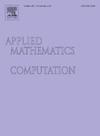Multistability and global attractivity for fractional-order spiking neural networks
IF 3.4
2区 数学
Q1 MATHEMATICS, APPLIED
引用次数: 0
Abstract
Fractional-Order Spiking Neural Network (FOSNN) has the characteristic of infinite memory and neural impulses, which can more accurately describe neural network systems and demonstrate higher precision data processing capabilities in artificial intelligence. The neural spiking leads to multiple equilibrium points coexisting in the networks system. Multistability analysis mainly studies the problem of the multiple equilibrium points, which helps to improve the robustness and reliability of the networks. However, fractional calculus and neural spiking increase the theoretical difficulty of multistability and attractivity analysis in neural networks, which is the main motivation to study and discuss. Firstly, for a Hopfield type of FOSNN with pulse activation functions, the solution existence is proved according to Filippov solutions. Secondly, the state space is divided and the sufficient conditions for multistability are proposed and proved by using fixed point theorem, Laplace transform, Mittag-Leffler function monotonicity analysis, etc. Furthermore, the boundedness and global attractivity of FOSNN are discussed based on fractional-order Lyapunov method. Finally, using the fractional-order prediction correction algorithm, some numerical examples are conducted in order to verify the correctness for all proposed results.
分数阶尖峰神经网络的多稳定性和全局吸引性
分数阶脉冲神经网络(FOSNN)具有无限记忆和神经脉冲的特性,可以更准确地描述神经网络系统,在人工智能中表现出更高精度的数据处理能力。神经尖峰导致网络系统中多个平衡点共存。多稳定性分析主要研究多个平衡点问题,有助于提高网络的鲁棒性和可靠性。然而,分数阶微积分和神经尖峰增加了神经网络多稳定性和吸引性分析的理论难度,这是研究和讨论神经网络的主要动力。首先,对于具有脉冲激活函数的Hopfield型FOSNN,根据Filippov解证明了解的存在性。其次,对状态空间进行划分,利用不动点定理、拉普拉斯变换、Mittag-Leffler函数单调性分析等方法,提出并证明了多稳定性的充分条件;此外,基于分数阶Lyapunov方法讨论了FOSNN的有界性和全局吸引性。最后,利用分数阶预测修正算法,通过数值算例验证了所提结果的正确性。
本文章由计算机程序翻译,如有差异,请以英文原文为准。
求助全文
约1分钟内获得全文
求助全文
来源期刊
CiteScore
7.90
自引率
10.00%
发文量
755
审稿时长
36 days
期刊介绍:
Applied Mathematics and Computation addresses work at the interface between applied mathematics, numerical computation, and applications of systems – oriented ideas to the physical, biological, social, and behavioral sciences, and emphasizes papers of a computational nature focusing on new algorithms, their analysis and numerical results.
In addition to presenting research papers, Applied Mathematics and Computation publishes review articles and single–topics issues.

 求助内容:
求助内容: 应助结果提醒方式:
应助结果提醒方式:


